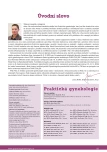-
Medical journals
- Career
Are the caesarian section and birthweight associated with alergies?
Authors: D. Hrubá 1; L. Kukla 2; M. Tyrlík 3; H. Matějová 1
Authors‘ workplace: Ústav preventivního lékařství, LF MU Brno 1; Ústav sociálního lékařství a veřejného zdravotnictví, oddělení preventivní a sociální pediatrie, LF MU Brno 2; Psychologický ústav, FF MU Brno 3
Published in: Prakt Gyn 2009; 13(3): 134-136
Overview
Antenatal and perinatal factors (gestational age, birth weight, section caesarea) were described as potential determinants of children allergy. This publication analyses data obtained for a cohort of 6,335 children in the ELSPAC Study. At the third year of their age, 19.9% of them had one, 2.9% had two or more allergic diseases, and 77.2% had no allergic symptoms. In all three groups, the similar frequency of delivery by section caesarea has occured (8.5% in average) and also the lenght of gestational age was the same (mean: 39.7 weeks, s. d. 1.0–1.3; 95% CI 39.7–39.8). The highest frequency of atopic eczema, urtica and other non‑specified allergies has been found among the children with high birth weight (> 4,000 g) compared to groups of children with low and normal birth weight, but levels of differences were not significant. Diagnosis of allergic rhinitis and asthma was similarly frequent in all three groups. At the 18 months of children’s life, the prevalence of all allergies was the highest among those with normal birth weight (2,501–4,000 g, p < 0.05), the lowest among children with the low birth weight (< 2,500 g). In the ELSPAC children, the possible associations between high birth weight and allergies in childhood were foreshadowed.
Key words:
allergy – gestational age – birth weight – caesarean section
Sources
1. Bager P, Melbye M, Rostgaard K et al. Mode of delivery and risk of allergic rhinitis and asthma. J Allergy Clin Immunol 2003; 111 : 51–56.
2. Bellanti JA, Malka-Rais J, Castro HJ et al. Developmental immunology: clinical application to allergy-immunology. Ann Allergy Asthma Immunol 2003; 90 (Suppl 3): 2–6.
3. Bolte G, Schmidt M, Maziak W et al. The relation of markers of fetal growth with asthma, allergies and serum immunoglobulin E levels in children at age 5–7 years. Clin Experim Allergy 2004; 34 : 381–388.
4. Brown M, Gustafson M, Saldana S et al. Correlation of human decidual and cord blood mononuclear cell cytokine production. Human Immunol 2004; 65 : 1336–1343.
5. Downs SH, Marks GB, Sporik R et al. Continued increase in the prevalence of asthma and atopy. Arch Dis Child 2001; 84 : 20–23.
6. Eggesbo M, Botten G, Stigum H et al. Is delivery by caesarean section a risk factor for food allergy? J Allergy Clin Immunol 2003; 112 : 420–426.
7. Hesselmar B, Dahlgren J, Wennergen G et al. Born small for gestational age: relation to future allergy and asthma. Acta Pediatr 2002; 91 : 992–994.
8. Hikino S, Nakayama H, Yamamoto J et al. Food allergy and atopic dermatitis in low birthweight infants during early childhood. Acta Pediatr 2001; 90 : 850–855.
9. Holt PG, Sly PD. Interaction between respiratory tract infections and atopy in the aethiology of asthma. Eur Respir J 2002; 19 : 538–545.
10. Hopkin JM. Early life receipt of antibiotics and atopic disorder. Clinical Experimental Allergy 1999; 29 : 733–734.
11. Kerkhof M, Koopman LP, van Strien RT et al. Risk factors for atopic dermatitis in infants at high risk of allergy: the PIAMA study. Clin Experim Allergy 2003; 33 : 1336–1341.
12. Koppen S, de Groot R, Neijens HJ et al. No epidemiological evidence for infant vaccinations to cause allergic disease. Vaccine 2004; 22 : 3375–3385.
13. Lewis SA, Britton JR. Consistent effects of high socioeconomic status and low birth order, and the modifying effect of maternal smoking on the risk of allergic disease during childhood. Respir Med 1998; 92 : 1237–1244.
14. Niegele K, Heinrich J, Borte M et al. Mode of delivery and development of atopic disease during the first 2 years of life. Pediatr Allergy Immunol 2004; 15 : 48–54.
15. Rabby BA, Celedon JC, Litonjua AA et al. Low-normal gestational age as a predictor of asthma at 6 years of age. Pediatrics 2004; 114: E327–E332.
16. Siltanen M, Kajosaari M, Pohjavuori M et al. Prematurity at birth reduces long‑term risk of atopy. J Allergy Clin Immunol 2001; 107 : 229–234.
17. Strachan DS. Family size, infection and atopy: the first decade of the „hygiene hypothesis“. Thorax 2000; 55 (Suppl 1): S2–S10.
Labels
Paediatric gynaecology Gynaecology and obstetrics Reproduction medicine
Article was published inPractical Gynecology

2009 Issue 3-
All articles in this issue
- Are the caesarian section and birthweight associated with alergies?
- Screening of disturbances of thyroid gland during pregnancy and postpartum
- Malignant tumors of vulva
- Lichen sclerosus.
- Lymfoedema of the upper extremity after breast cancer therapy.
- Antichlamydial antibodies occurrence in men and women.
- Forensic aspects of assisted reproduction within the legislation context of the Czech and Slovak Republics.
- Practical Gynecology
- Journal archive
- Current issue
- Online only
- About the journal
Most read in this issue- Lichen sclerosus.
- Malignant tumors of vulva
- Screening of disturbances of thyroid gland during pregnancy and postpartum
- Forensic aspects of assisted reproduction within the legislation context of the Czech and Slovak Republics.
Login#ADS_BOTTOM_SCRIPTS#Forgotten passwordEnter the email address that you registered with. We will send you instructions on how to set a new password.
- Career

